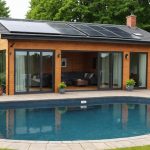In the damp, and frequently changing weather of the UK, maintaining the aesthetics of your home and garden can be an uphill task. One common issue homeowners struggle with is the persistent growth of algae and mold. These growths can be unsightly, and if left unchecked, they can damage your property and pose health risks. The question is, how do you manage these unruly guests in such a climate? In this article, we delve into the effective methods deployed to control algae and mold in damp UK climates.
Understanding the Enemy: Algae and Mold
Before you can effectively combat algae and mold, it’s essential to understand what you’re dealing with. Both of these organisms thrive in damp, low-light conditions, making the UK’s climate a prime breeding ground.
A lire en complément : Maximizing Rainwater Use: A Guide to Efficiently Powering Your UK Home Swimming Pool
Algae, typically green in color, grow on surfaces exposed to sunlight and moisture. Often, you’ll find it on your garden furniture, fences, patios, or roofs. On the other hand, mold, often black or white, prefers the dark, moist corners of your house. It usually resides in your bathrooms, kitchens, basements, or any area where humidity is high.
Over time, these organisms can cause significant damage. Algae, for instance, can create a slippery layer on surfaces, posing a risk of accidents. Mold, on the other hand, can exacerbate allergies and respiratory issues. Thus, managing these nuisances is not only about preserving your home’s aesthetic appeal – it’s also about safety and health.
Lire également : How Your Garden Design Can Impact the Water Quality of Your UK Home Swimming Pool
Preventive Measures: Stopping Growth Before It Starts
The old adage ‘prevention is better than cure’ applies perfectly when dealing with algae and mold. By making your home less inviting to these organisms, you’ll reduce their chances of making an appearance.
Begin with monitoring and controlling humidity levels in your home. Maintain a level between 40-60% to create an environment less conducive to mold growth. Investing in a dehumidifier or air conditioner can help ensure this. Also, regular airing of rooms, especially those prone to dampness, can keep humidity in check.
For outdoor areas, frequent cleaning can discourage algae growth. Regularly sweep your patios, driveways, and decks to remove dirt and debris, which can hold moisture and facilitate algae growth. Ensure proper drainage is in place to prevent standing water, a perfect breeding ground for algae.
Cleaning Techniques: Removing Existing Algae and Mold
In case of an already existing infestation, a thorough cleaning is in order. Start by identifying all affected areas. For indoor mold, check for musty smells and discoloration on walls and ceilings. For algae, look for green, slippery surfaces.
Next, gear up for cleaning. Always wear protective gear – gloves, goggles, and a mask – to protect yourself from harmful spores. For mold, a solution of one part bleach to four parts water is effective. Scrub the affected surfaces with this solution using a stiff brush. For stubborn mold stains, consider using a mold remover product.
When cleaning algae, a pressure washer can be your best friend. It can effectively blast away algae from hard surfaces such as patios and driveways. Alternatively, you can use a bleach solution similar to the one used for mold. However, remember to protect your plants from the bleach by covering them or rinsing them with water before and after cleaning.
Professional Help: When to Call in the Experts
Sometimes, despite your best efforts, algae and mold can prove to be stubborn adversaries. If you’ve cleaned repeatedly and the problem persists, it could be time to call in professionals. They will not only help you eradicate the issue but also identify and rectify any underlying problems contributing to the growth.
Professional mold remediation companies have access to specialized equipment and products that can deal with severe infestations more effectively. They also understand the health risks associated with mold and can carry out the work in a way that minimizes the risk of exposure.
Similarly, professionals can handle algae cleaning in tricky areas like the roof, where doing it yourself can be dangerous. Their expertise can help restore your home to its former glory, free from unsightly and damaging algae and mold.
Conclusion
Living in the UK’s damp climate doesn’t mean you have to resign yourself to a constant battle with algae and mold. By understanding these growths, taking preventive measures, employing effective cleaning techniques, and knowing when to call professionals, you can keep your home looking its best. More importantly, you can safeguard the health of yourself and your loved ones.
Remember, while maintaining a clean and algae or mold-free environment may require some effort, the result – a safe, healthy, and beautiful home – is well worth it.
Future-proofing your Home: Building Resilience against Algae and Mold
Another essential strategy to fend off algae and mold growth lies in the construction and maintenance of your home. The resilience of your house against these organisms is determined by how well it can withstand damp and humidity.
Use water-resistant materials in areas prone to dampness like bathrooms and basements. For instance, opt for moisture-resistant drywall or ‘green board’ for your bathroom walls and ceilings. Also, consider using tile or vinyl for your bathroom floors. These materials can withstand high humidity levels without facilitating mold growth.
Ensure your home has adequate ventilation. Install exhaust fans in your bathrooms and kitchens to expel moist air. Use vented soffits and ridge vents in your attics to prevent condensation, a common cause of mold in lofts. Additionally, keep your gutters and downspouts clean and in good working condition to prevent water build-up and seepage into your home – a sure invitation for mold.
For your garden and outdoor spaces, consider using algae-resistant materials. For example, choose algae-resistant roofing shingles to keep your roof algae-free. Install permeable paving for your driveways and patios to prevent water pooling and subsequent algae growth.
By building and maintaining a home resistant to damp and humidity, you can drastically reduce the likelihood of algae and mold taking hold and save yourself considerable time and resources in the long run.
Regular Maintenance: An Integral Part of Mold and Algae Management
Regular maintenance is a crucial element of successful algae and mold management. This involves consistently checking for signs of these organisms and taking prompt action when they are detected.
Regularly inspect your home for any signs of mold. This includes checking for musty smells, condensation on windows, and discoloration on walls and ceilings. Be particularly vigilant during the colder months when windows are frequently closed, and heating systems can increase the humidity levels in your home.
For your outdoor spaces, routinely clean your garden furniture, fences, and patios to prevent algae build-up. Trim overhanging branches to allow sunlight to reach these surfaces, as this can deter algae growth.
Remember, early detection and intervention are key to preventing an algae or mold problem from escalating. By being diligent with regular maintenance, you can keep your home in top shape and prevent these unwelcome guests from making themselves at home.
Conclusion
In the damp UK climate, managing algae and mold can pose a significant challenge. However, with a comprehensive understanding of these organisms and a proactive approach to their management, you can keep your home and garden looking pristine. Whether it’s through preventive measures, regular cleaning, resilient construction techniques, or timely professional help, each step plays a vital role in maintaining a healthy, algae, and mold-free environment.
While it may require a certain level of commitment and effort, the end result – a beautiful, safe, and healthy home – is certainly worth it. So don’t let the UK’s damp weather dampen your spirits. With the right strategies, you can conquer algae and mold and enjoy your home to the fullest.











